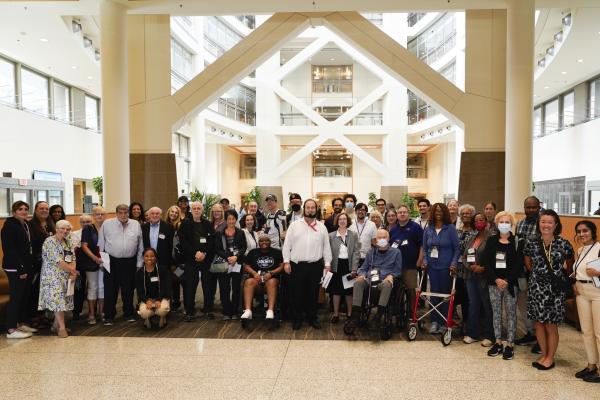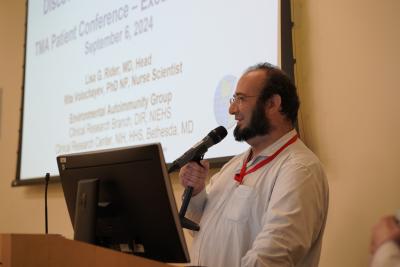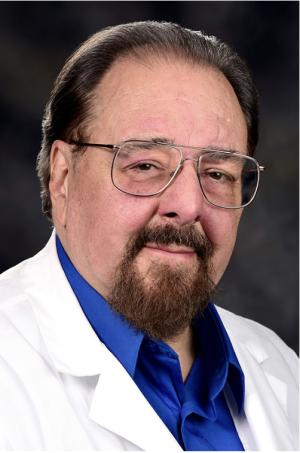NIH Hosts Myositis Conference Attendees
Thirty-five Visitors Learned About NIH Clinical Research, Emerging Treatment Options
BY LINDSAY KEY

CREDIT: MARIA MASLENNIKOV, CC
Patients with myositis visited the NIH for a full day of talks, tours, and networking.
People living with myositis learned about research to advance understanding and treatment of the disease during presentations and a tour of the Clinical Center (CC) in Bethesda, Maryland, on September 6. Myositis refers to a set of autoimmune diseases involving chronic inflammation of the muscles. An estimated 75,000 people living in the United States are affected, according to The Myositis Association (TMA).
NIEHS, based in North Carolina, partnered with the CC, NIAMS, and TMA to coordinate this inaugural event. Patients and caregivers attended research-focused talks, toured clinical research facilities, and learned how to enroll in NIH studies. The small group tours, which were led by staff from the NIEHS Environmental Autoimmunity Group and NIAMS research groups studying juvenile myositis and adult myositis, helped attendees get an idea of what it is like to be a patient at the NIH.
Paula Eichenbrenner, TMA executive director, said the visit was an outstanding opening event for TMA’s annual international patient conference, which took place in Baltimore September 6–8. “We learned about the latest developments in myositis science and the highly successful, innovative connection between TMA and NIEHS,” she said about the conference’s off-site excursion offering.
Pinpointing risk factors

CREDIT: MARIA MASLENNIKOV, CC
Lisa Rider, left, and Rita Volochayev, nurse practitioner in the Environmental Autoimmunity Group, discussed current myositis research and discoveries.
NIEHS scientists have researched myositis for more than 40 years. This rare and complex group of illnesses occurs when the immune system attacks muscles in the arms, legs or hips, abdomen, and back.
Types of myositis include dermatomyositis, antisynthetase syndrome, necrotizing myopathy, inclusion body myositis, polymyositis, and juvenile forms of myositis. With no known cure, physicians focus on treating symptoms and the underlying inflammatory processes. These symptoms include muscle pain and weakness, fatigue, photosensitive skin rashes, swelling, and trouble breathing or swallowing.
The incidence of myositis, along with other autoimmune disorders, is rising in the United States, according to Lisa Rider, who leads the NIEHS Environmental Autoimmunity Group. A better understanding of the environmental influences driving the development of the disease, along with genetic risk factors, is needed, she said.
NIEHS scientists have used information from a TMA-led patient registry called MYOVISION to divide patients into subgroups, or phenotypes, to better understand myositis, as well as from environmental risk-factor studies led by NIEHS from the CC. They have identified ultraviolet sun exposure, smoking, stressful events, and exposure to silica and solvents as environmental risk factors, explained Rider.
“Our new approaches and technologies are allowing us to carefully define these myositis phenotypes, to identify these genetic and environmental factors, and to look at their interactions,” she said.
A patient-centered approach

CREDIT: MARIA MASLENNIKOV, CC
“I hope patients came away understanding more about clinical studies, what participating in a study at NIH is like, and the history of advances NIH has made to improve the understanding, evaluation, and treatment of myositis,” said Adam Schiffenbauer, who organized the event.
In addition to research advances, attendees also learned about new physical therapy techniques for myositis from the CC’s rehabilitation medicine team. Following a lecture led by Kakali Sarkar, an NIEHS Environmental Autoimmunity Group biologist, they toured a myositis research laboratory and biorepository, where patient biospecimens are stored. The group also heard about advanced imaging techniques for myositis from Adam Schiffenbauer, deputy head and associate research physician in the NIEHS Environmental Autoimmunity Group.
NIEHS’s longstanding partnership with TMA has been crucial to advancing research, according to Schiffenbauer. He noted that patient feedback about the disease has helped his team identify new lines of inquiry. “We depend on the patients,” Schiffenbauer said. “We couldn’t do any of the research we do without them.”
Martha Arnold, a TMA board member living with inclusion body myositis, said the NIH staff presentations were a highlight of the visit. “Their passion and dedication shone through, and our visit reassured me that excellent work is being done to advance science across myositis diseases,” she said.

Lindsay Key is a contract writer for the NIEHS Office of Communications and Public Liaison. The original version of this article and a list of citations is available here.
Pioneering Myositis Research

CREDIT: STEVE MCCAW, NIEHS
Frederick Miller studied myositis for more than 40 years.
When Frederick Miller joined NIAMS as a rheumatology fellow in the 1980s, he encountered a patient who shaped the rest of his career.
“One of the first patients referred to us from our dermatology colleagues was a very sick man developing severe dermatomyositis right before our eyes,” said Miller, who retired in 2021. “We admitted him to the rheumatology service and realized how little was known about this rare autoimmune disease at that time.”
That was the start of a 40-year career focused on myositis research for Miller, who went on to become head of the NIEHS Environmental Autoimmunity Group and a role model for Rider, Schiffenbauer, and many other scientists. Miller retired in 2021 after publishing more than 330 research publications, reviews, books, and book chapters on myositis and other autoimmune diseases.
He co-established and is emeritus coordinator of the International Myositis Assessment and Clinical Studies Group (IMACS) and established the Myositis Genetics Consortium, which is now a part of IMACS. As an early member of the Myositis Association of America’s board of directors, Miller suggested the group expand its scope internationally, to become what is known today as The Myositis Association.
The International Myositis Assessment and Clinical Studies Group/Juvenile Dermatomyositis Working Group Annual Meeting 2024 will take place on November 6, 8 a.m. to 2 p.m. Click here for more information.
This page was last updated on Tuesday, November 5, 2024
